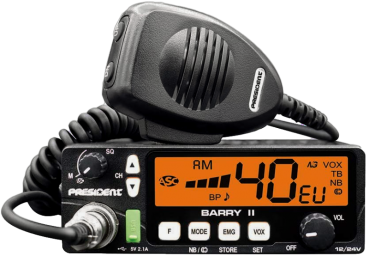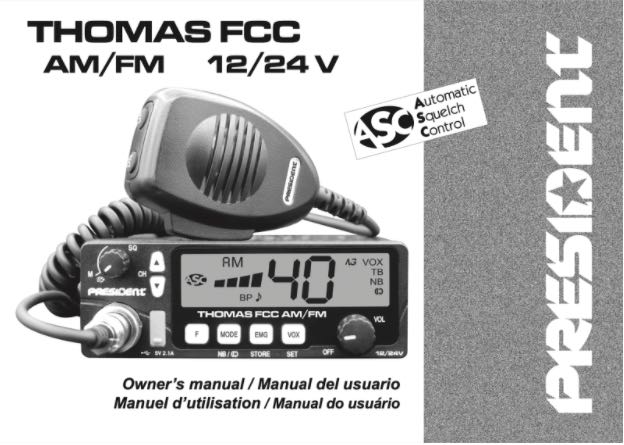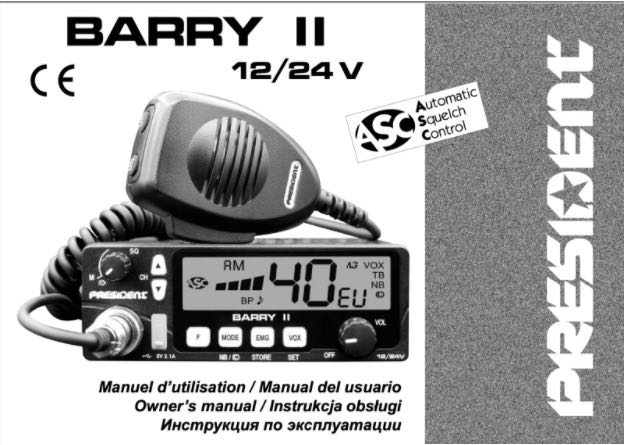 Many thanks to SWLing Post contributor, Peter Laws, who shares the following guest post:
Many thanks to SWLing Post contributor, Peter Laws, who shares the following guest post:
Thomas – Still Famous
by Peter Laws
We’re getting closer to the first legal FM CB on the market in the USA. President Electronics USA has announced that the President Thomas FCC CB radio will hit dealers in early 2022.
When first reporting on this, the assumption was that the Thomas FCC was going to be an FCC-spec Thomas ASC, a somewhat long in the tooth European multi-norm set. As the release date has approached, and President has released marketing collateral, it’s apparent that this new product is, in fact, a rebranded President Barry II, a current-production state-of-the-CB-art AM/FM European multi-norm model.
Richard, G0OJF, a pipe organ restoration and two-way radio expert from Lincolnshire, England, runs a wonderful YouTube channel “UK FM CB radio servicing”, where he restores old UK-spec CBs and then tests them on air. He also tunes up newly-released UK-spec CBs … and occasionally demonstrates restoration of 150-year-old pipe organs. He recently covered the Barry II so if you are curious about the Thomas FCC you are strongly encouraged to watch his video about its European counterpart.
Your humble reporter, who, perhaps surprisingly, has not followed the CB radio market since, (checks notes), 1977 or so, was amazed to see that the MSRP will be $109. In 1976 terms, that’s just under 25 bucks and had CBs been that price then, your reporter would have bought three because he’d been saving his pennies and that was the amount he’d saved!
Undoubtedly, the reduction in cost is from using components that are readily assembled by robots. If you watch G0OJF’s video above, you’ll note that the unit is almost completely made of surface-mount components. Remarkable.
Watch for dealers to begin offering these in the next few weeks. Your reporter plans to buy one and will be hanging out on Channel 31 FM once it’s installed in his radio room. Presumably, President (and other vendors) will be watching to see how these units sell in order to make plans for releasing other CBs that include FM. An AM/FM/SSB CB would be quite versatile!
Let’s play a game: Spot the differences!
Full manuals for both versions are here:



Second model to be approved appears to be the Uniden “Bearcat” 880FM. If you dig up the stuff from the FCC / OET site, there is a little sloppiness in the Test Report and elsewhere. I am no expert, but I’m confident that the new unit will not have a 100% duty cycle or a Type N antenna connector. Likewise, I doubt the emission designators are 2M88F3E and 2M82A3E for FM and AM respectively … K, surely, and not M.
Personally, I wish they’d do a 980SSBFM – I want ALL the modes! I suspect this was cheaper for Uniden (remember, the radios exist elsewhere!) and a good test of the market for FM. Still going to probably get a Thomas FCC whenever people start actually stocking them!
Thanks Thomas for this post on FM CB sets and Richard’s YouTube channel.
Luckily my Yaesu FRG-100 shortwave receiver has the FM board installed, this way I can listen for this new CB mode.
At my QTH (central NJ) CB is very quiet except during band openings so it’ll be interesting to see if local activity picks up. Wonder if truckers will be tempted to install these new CBs in their rigs? Back in the ’70s channel 19 was very busy with truck traffic.
I agree with Thomas about the low price for these new CB FM sets; very reasonable indeed. I spent $300 for a new Midland AM/SSB radio in the ’70s. You can get one nowadays for half that price.
I went looking for the FCC rules for FM CB and I could not find any reference on the FCC website.
According to https://www.ccjdigital.com/products/article/15114521/fcc-approves-fm-mode-for-cb-radios the rules will not be published along with a start date until 2022.
..,can someone please explain why such a bid deal about FM, in this case?
..CB radio was popular in the 1970’s, truck driving songs, but what with FM?
The chief advantage will be better resistance to common noise sources, such as power lines and outdoor lighting systems. As the ionosphere improves going into Cycle 25, we’ll have more random noise from distance sources (chiefly lightning) to deal with, and FM Will help with that too.
Mike,
Most think that FM will be like FM broadcast radio “noise free, undistorted with high frequency sounds”
To achieve this the FM broadcast channel is 200 kHz wide. The loudest mono sounds have a frequency deviation of 75 kHz and there is also up to18 dB high frequency sound boost prior to transmission
The CB channels are only 10 kHz wide. This means that the frequency range is reduced to around 3.5 kHz, the deviation is yet to be specified but must be much lower than broadcast. Thus the modulation index for broadcast is = maximum deviation/maximum frequency =75/15 = 5.
CB is narrow band FM the MI will be between 0.2 – 0.5. As a result, the noise performance of FM CB will only be a little better than AM. The high frequency audio boost is largely ineffective due to the 3.5 kHz high frequency limit.
The main advantage of FM is that the strongest signal is the only one which is heard, where as in AM and SSB you hear the stronger and weaker signals simultaneously, with the weaker signal at a lower volume.
Sideband gives you the best range on CB. I don’t see FM on CB increasing range. Handheld CB radios are very inefficient at 27Mhz if you use a rubber duck, so even with 4 watts output, I bet the 1 watt GMRS radios would do much better, since more efficient antennas for handhelds can be had in the 400 Mhz band. I guess you would be better copied during a lightning storm, but I would only use a handheld under such conditions, and 27Mhz dosen’t work well for handheld use.
For all those interested in the frequencies available to the public in the USA I suggest you read about the different services in
https://www.fcc.gov/wireless/bureau-divisions/mobility-division/personal-radio-services
There are channels in the HF, VHF and UHF bands.
Question is, will there be a big advertising blitz about ‘FM for CB!’? With the exception of some hobbyists, who even knows about FM for CB for the USA market? If they were to put these are portables, then hunters would like these, since they did in the 70’s, 80’s and 90’s, and would actually reach for miles in the tough terrain around here. Unlike UHF FRS, which can be heard about as far as you can throw one. And, VHF MURS??? Better, but not cost effective for most users. Not to mention that most folks out there have never heard of MURS, and Motorola and Radio Shack just assume that it is kept that way. So, we’ll see.
You already have one in the VHF band https://www.fcc.gov/wireless/bureau-divisions/mobility-division/220-mhz-services which makes 218 – 219 MHz available containing 80 channels.
My October post
“In Australia, this was an option a long time ago and was dropped because very narrow band FM performance approaches AM in the 27 MHz. We have 476.4250 and 477.4125 MHz FM CB radio which is now much more popular than 27 MHz. These UHF frequencies are used in the Americas and Europe for TV.
In the 27 MHz band, SSB (12 W)/AM (6W) is used instead. The use of SSB means a doubling of the available channels compared to AM and FM. The range is increased because all of the battery power is used for the voice signals and not wasted on an AM carrier and for FM the power output of the transmitter is constant. With SSB silence means no power transmitted and the greater the volume of the sound the greater the power transmitted.
As Desmond mentioned CB radio is very old, and has been replaced by digital two way radios in many professional situations such as the emergency services, mining companies….. The advantage is that they have selective calling better sound, 20 % increase in coverage and upto 50 % longer battery life.
Check out two way radios for the VHF high band and UHF.”
The UHF CB channels available in Australia are used for TV in the USA.
The 218 to 219 MHz in the US is not for public use as you said. Your link pointed out the millions of dollars of auction money in this band, so it should have explained it well.
The license free or easy / cheap for public use services in the US are these only: 27 CB, 462/467 FRS, 462/467 GMRS, 150 MURS,
And to a lesser extent, 902-928 ISM, 49 MHz low power also have 2 way radios made in these.
And that’s all unless it’s super low power that is under exemption from the FCC
218,219 is not among them.
I fully agree Tha Dood, it all depends on how much they advertise and promote. The only difference between now and the 1970s, when CB was very popular is that back then we had electronic stores like Lafayette Radio and Radio Shack in many locations throughout the US where you shop for one. We also had a magazine (S9) devoted to the hobby. Even Sears and Roebuck sold them.
And you are correct in that CB portables were advertised for sportsmen’s use – just take a look at old Lafayette catalogs and see how they envisioned CB’s usefulness for farmers, construction sites, etc. A handheld CB radio with full 5W input would have better range over GMRS with one caveat – the CB would need a fully extendable antenna like the old units for optimal range. Stealth would have to take a backseat somewhat.
Well I hope CB FM injects some life into the 11m band. Time will tell.
Can another swing at AM STEREO be far behind ?! 🙂
It’s already here in the USA it’s called HD radio in the AM band.
The modern version is Digital Radio Mondiale which will give noise, distortion free stereo sound in the 530 – 1720 kHz band. The FCC hasn’t even tested it. It is on air in India from 35 transmitters from 10 kW to 1,000 kW or 1 MW. The highest power AM in the USA is 50 kW.
We have a ton of activity in the greater Seattle area. I can only see FM with no extra channels disrupting CB to the point of ruining the band for all the reasons we use it currently.
I think it is a government ploy.
What is the point of FM CB in the US? Other than truckers, virtually no one uses CB here. I have no idea what need this company is trying to fill.
FM, yeh great (not) had over in UK for ages and because of the ‘Capture Effect’ you can’t hear weak FM signals, A M. and particularly SSB are far superior. Ok for local contact FM is fine and Yes it’s more immune to man made noise. As mentioned 27MHz is fairly poor for local contacts anyway with VHF and UHF being much more efficient, smaller antennas etc. Folk are just being nostalgic most of the time as in the 80s the band was wide open to the world and is, generally, every 11 years of so with the sunspot cycle. Having FM as an operating mode will change nothing and just force folk to spend more money. Why bother!
Peter, thank you so much for keeping us up to date on FM CB’s US debut!
And the UK FM CB Radio Servicing Channel? Watching it right now! 🙂
Thanks, Peter!